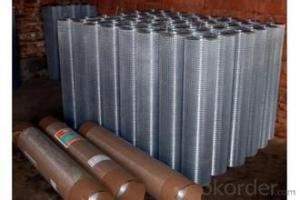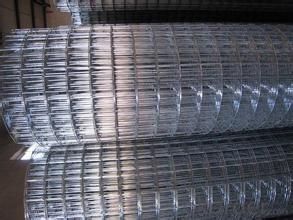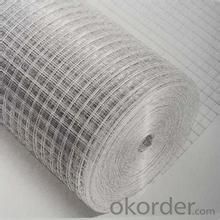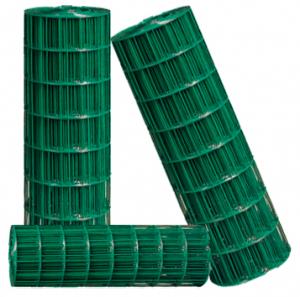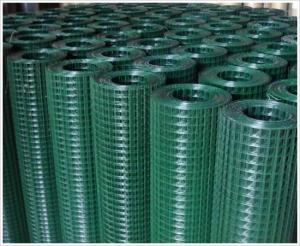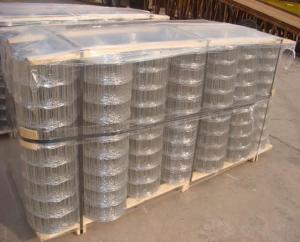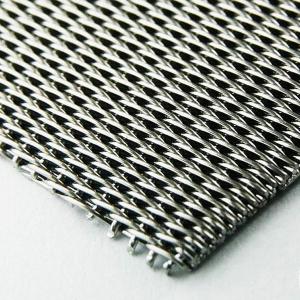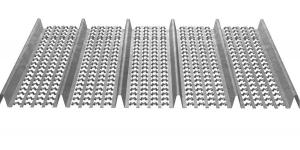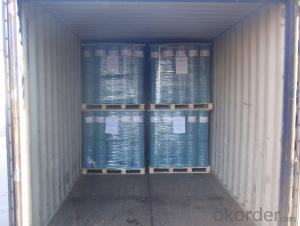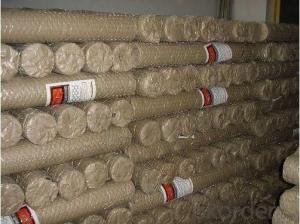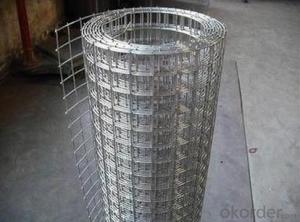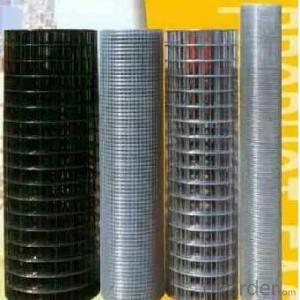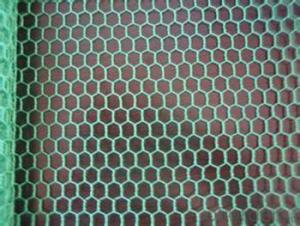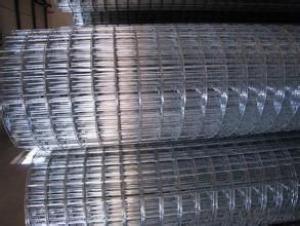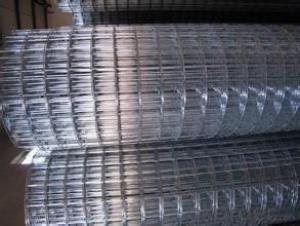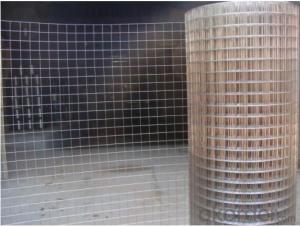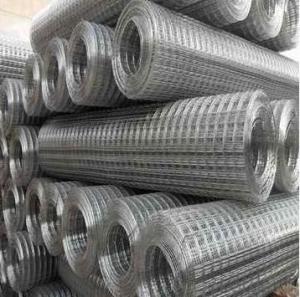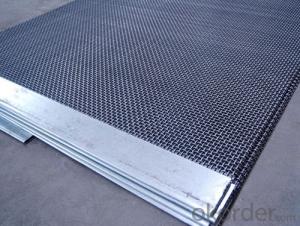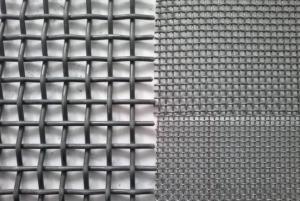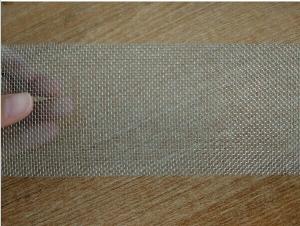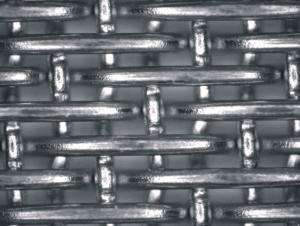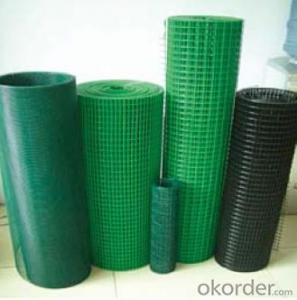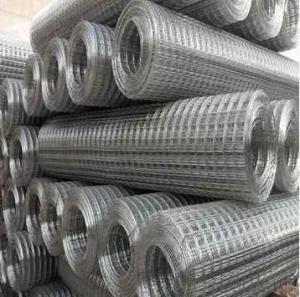Welded Wire Mesh for Construction -3/4 X 3/4
- Loading Port:
- Tianjin
- Payment Terms:
- TT or LC
- Min Order Qty:
- 50 roll
- Supply Capability:
- 5000 roll/month
OKorder Service Pledge
OKorder Financial Service
You Might Also Like
Introduction of Welded Wire Mesh
Welded Wire Mesh is made of by high quality galvanized wire, Low carton steel wire, stainless steel wire, iron wire, Galvanized steel wire, PVC coated iron wire in blue, green, yellow and other colors.
Application of Welded Wire Mesh
Galvanized welded wire mesh, PVC coated welded wire mesh for garden, feeding agriculture, fishing, poultry, mine field, lawn cultivation, and profession’s guard, decorate machine protection. Special welded wire mesh, (Heavy)welded wire mesh panel service as fencing mesh for transportation industry, construction a agriculture.
Surface treatment of of Welded Wire Mesh
a. Black (mild steel wire)
b. Electro galvanized, (galvanized before welding, galvanized after welding)
c. Hot dip galvanized, (galvanized before welding, galvanized after welding)
d. Pvc coated welded wire mesh, (black wire mesh then pvc coated, electro gal. then pvc coated, hot dip gal. the pvc coated)
Advantage of Welded Wire Mesh
Our welded wire mesh has strong corrosion-resisting and oxidation-resisting with good quality and rock bottom price.
Packing of Welded Wire Mesh
1. Waterproof paper then PVC shrinking Film
2. PVC shrinking film only
3. Black waterproof paper only
4. Waterproof paper then metal/wooden pallet
5. Plastic film then carton
(Also as your request. )
Pictures of Welded Wire Mesh
Specification of Welded Wire Mesh
Standard Welded Wire Mesh (in 30m length, Width of 0.5m-1.8m) | ||
Mesh | Wire Gauge (BWG) | |
Inch | MM | |
1/4" x 1/4" | 6.4mm x 6.4mm | 22-24 |
3/8" x 3/8" | 10.6mm x 10.6mm | 19-22 |
1/2" x 1/2" | 12.7mm x 12.7mm | 16-23 |
5/8" x 5/8" | 16mm x 16mm | 18-21, |
3/4" x 3/4" | 19.1mm x 19.1mm | 16-21 |
1" x 1/2" | 25.4mm x 12.7mm | 16-21 |
1-1/2" x 1-1/2" | 38mm x 38mm | 14-19 |
1" x 2" | 25.4mm x 50.8mm | 14-16 |
2" x 2" | 50.8mm x 50.8mm | 12-16 |
1/4" x 1/4" | 6.4mm x 6.4mm | 12-16 |
Welded Fencing Mesh (in 30m Length, Width of 0.5m -1.8m) | ||
Mesh | Wire Gauge (BWG) | |
Inch | MM | |
2" x 3" | 50mm x 75mm | 1.65-2.5mm |
3" x 3" | 75mm x 756mm | 1.65-2.75mm |
2" x 4" | 50mm x 100mm | 2.1-2.9mm |
4" x 4" | 100mm x 100mm | 2.0mm,2.5mm |
FAQ
We have organized several common questions for our clients,may help you sincerely:
1. How about your company?
A world class manufacturer & supplier of welded wire mesh and is one of the large-scale professional investment welded wire mesh bases in China. Annually more than 1000 containers of welded wire mesh are exported to markets in Europe, America and Japan.
2. What is the storage condition?
The welded wire mesh should be stored at room temperature and kept from wet and heat source.
3. How to guarantee the quality of the products?
We have established the international advanced quality management system,every link from raw material to final product we have strict quality test;We resolutely put an end to unqualified products flowing into the market. At the same time, we will provide necessary follow-up service assurance.
4. How long can we receive the product after purchase?
In the purchase of product within four working days, we will arrange the factory delivery as soon as possible. The specific time of receiving is related to the state and position of customers. Commonly 7 to 10 working days can be served.
- Q: What are the different thickness options available for steel wire mesh?
- Steel wire mesh offers various thickness options to meet specific application requirements. Gauge or wire diameter is used to measure the thickness of steel wire mesh. Steel wire mesh is available in common thickness options ranging from 4 gauge (5.19 mm or 0.2043 inches) to 30 gauge (0.25 mm or 0.0098 inches). However, it's important to note that thickness can vary within these ranges due to slight variations in wire diameters offered by different manufacturers. The choice of thickness depends on factors such as the intended use, required strength and durability, and the size of openings required for the application. For heavy-duty applications like industrial screens or fencing, a thicker gauge wire mesh is suitable to ensure strength and impact resistance. On the other hand, for lightweight applications like insect screens or decorative purposes, a thinner gauge wire mesh may be appropriate. To determine the most suitable thickness option for your specific needs, it is advisable to consult a reputable supplier or manufacturer. They can provide guidance considering your desired application, budget, and other factors to ensure the selection of the most appropriate thickness for your steel wire mesh.
- Q: Can steel wire mesh be used for reinforcement purposes?
- Yes, steel wire mesh can be used for reinforcement purposes. It is commonly used as a reinforcing material in concrete structures to improve their strength and durability. The mesh provides added tensile strength to the concrete, preventing cracks and enhancing its overall structural integrity.
- Q: What are the aesthetic options available for steel wire mesh?
- The aesthetic options available for steel wire mesh include different wire sizes and gauges, various patterns and weaves, and a range of finishes such as galvanized, powder-coated, and stainless steel options. Additionally, steel wire mesh can be customized with different colors, textures, and even incorporate decorative elements like etching or laser-cut designs.
- Q: Is steel wire mesh suitable for electrical grounding?
- Yes, steel wire mesh is suitable for electrical grounding. It offers low resistance to electrical flow and can effectively disperse electrical charges to the ground, making it a reliable option for grounding systems.
- Q: What are the different wire diameters available for steel wire mesh?
- There are various wire diameters available for steel wire mesh, depending on the specific application and requirements. Common wire diameters for steel wire mesh range from as small as 0.5mm (0.02 inches) to as large as 12mm (0.47 inches). However, it is important to note that the availability of wire diameters may vary depending on the mesh opening size and the intended use of the steel wire mesh. For finer mesh openings, such as those used in insect screens or filtration applications, the wire diameters are typically smaller, ranging from 0.5mm to 2mm (0.02 to 0.08 inches). These finer wire diameters allow for better filtration and retention of smaller particles or insects. On the other hand, for coarser mesh openings used in fencing or construction applications, the wire diameters tend to be larger. In such cases, wire diameters can range from 3mm to 12mm (0.12 to 0.47 inches), providing increased strength and durability to withstand higher loads and impacts. It is important to choose the appropriate wire diameter based on the specific requirements of the application. Factors such as the desired level of strength, flexibility, corrosion resistance, and the intended use of the steel wire mesh should all be taken into consideration when selecting the appropriate wire diameter.
- Q: How does steel wire mesh perform in high wind conditions?
- Steel wire mesh performs well in high wind conditions due to its strong and durable nature. The interlocking pattern of the wires provides stability and prevents the mesh from being easily blown away or damaged by the force of the wind. The high tensile strength of steel also allows the mesh to withstand the pressure and impact caused by strong winds, ensuring its integrity and preventing it from being compromised. Moreover, steel wire mesh is resistant to corrosion, which makes it suitable for outdoor applications even in harsh weather conditions. This resistance to rust and deterioration further ensures that the mesh retains its structural integrity and performance in high wind conditions over an extended period of time. Overall, steel wire mesh is an excellent choice for applications where wind resistance is a concern, providing reliable and long-lasting performance in such conditions.
- Q: Can steel wire mesh be used for gabion baskets?
- Yes, steel wire mesh can be used for gabion baskets. In fact, it is one of the most common materials used for constructing gabion baskets. Steel wire mesh is strong, durable, and able to withstand the forces exerted by soil and water. The mesh is typically made from galvanized or PVC-coated steel wire, which adds an extra layer of protection against corrosion. Additionally, steel wire mesh allows for proper drainage and prevents soil erosion, making it an ideal choice for constructing gabion baskets for various applications such as retaining walls, riverbank protection, and landscaping projects.
- Q: Can steel wire mesh be used for electrical grounding?
- Using steel wire mesh for electrical grounding is not possible. Electrical grounding necessitates a conductor that has low resistance in order to redirect electrical current safely to the ground in the event of a fault or surge. Although steel wire mesh conducts electricity, its resistance is higher when compared to other materials that are specifically engineered for grounding purposes. Materials like copper or aluminum conductors are preferred due to their exceptional conductivity and low resistance, which guarantee efficient and safe grounding. If steel wire mesh is utilized for electrical grounding, it may result in insufficient grounding and potential safety risks.
- Q: How is steel wire mesh used in the chemical manufacturing industry?
- Steel wire mesh is commonly used in the chemical manufacturing industry for various applications such as filtration, separation, and reinforcement. It is used as a sieve or filter medium to effectively separate solids from liquids or gases, ensuring the purity and quality of chemicals. Steel wire mesh is also utilized as a reinforcement material in chemical tanks, vessels, and other equipment to provide structural strength and prevent deformation under high pressure or temperature conditions.
- Q: How is steel wire mesh used in reinforcement of educational and institutional buildings?
- Steel wire mesh is commonly used in the reinforcement of educational and institutional buildings to enhance their structural integrity. It is primarily used to strengthen concrete slabs, walls, and columns, providing increased resistance against cracks and structural failures. The steel wire mesh acts as a reinforcement material, distributing the load across the structure and improving its overall durability. Additionally, steel wire mesh also helps to prevent shrinkage and expansion of concrete, ensuring a longer lifespan for the building.
Send your message to us
Welded Wire Mesh for Construction -3/4 X 3/4
- Loading Port:
- Tianjin
- Payment Terms:
- TT or LC
- Min Order Qty:
- 50 roll
- Supply Capability:
- 5000 roll/month
OKorder Service Pledge
OKorder Financial Service
Similar products
Hot products
Hot Searches
Related keywords
